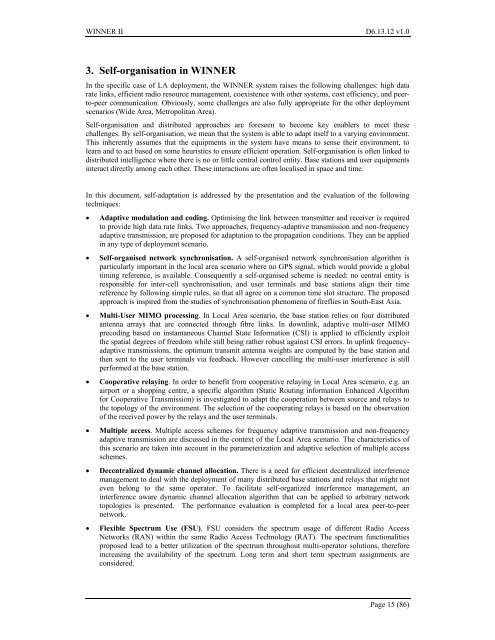IST-4-027756 WINNER II D6.13.12 v1.0 Final CG “local area ...
IST-4-027756 WINNER II D6.13.12 v1.0 Final CG “local area ...
IST-4-027756 WINNER II D6.13.12 v1.0 Final CG “local area ...
Create successful ePaper yourself
Turn your PDF publications into a flip-book with our unique Google optimized e-Paper software.
<strong>WINNER</strong> <strong>II</strong> <strong>D6.13.12</strong> <strong>v1.0</strong>3. Self-organisation in <strong>WINNER</strong>In the specific case of LA deployment, the <strong>WINNER</strong> system raises the following challenges: high datarate links, efficient radio resource management, coexistence with other systems, cost efficiency, and peerto-peercommunication. Obviously, some challenges are also fully appropriate for the other deploymentscenarios (Wide Area, Metropolitan Area).Self-organisation and distributed approaches are foreseen to become key enablers to meet thesechallenges. By self-organisation, we mean that the system is able to adapt itself to a varying environment.This inherently assumes that the equipments in the system have means to sense their environment, tolearn and to act based on some heuristics to ensure efficient operation. Self-organisation is often linked todistributed intelligence where there is no or little central control entity. Base stations and user equipmentsinteract directly among each other. These interactions are often localised in space and time.In this document, self-adaptation is addressed by the presentation and the evaluation of the followingtechniques:• Adaptive modulation and coding. Optimising the link between transmitter and receiver is requiredto provide high data rate links. Two approaches, frequency-adaptive transmission and non-frequencyadaptive transmission, are proposed for adaptation to the propagation conditions. They can be appliedin any type of deployment scenario.• Self-organised network synchronisation. A self-organised network synchronisation algorithm isparticularly important in the local <strong>area</strong> scenario where no GPS signal, which would provide a globaltiming reference, is available. Consequently a self-organised scheme is needed: no central entity isresponsible for inter-cell synchronisation, and user terminals and base stations align their timereference by following simple rules, so that all agree on a common time slot structure. The proposedapproach is inspired from the studies of synchronisation phenomena of fireflies in South-East Asia.• Multi-User MIMO processing. In Local Area scenario, the base station relies on four distributedantenna arrays that are connected through fibre links. In downlink, adaptive multi-user MIMOprecoding based on instantaneous Channel State Information (CSI) is applied to efficiently exploitthe spatial degrees of freedom while still being rather robust against CSI errors. In uplink frequencyadaptivetransmissions, the optimum transmit antenna weights are computed by the base station andthen sent to the user terminals via feedback. However cancelling the multi-user interference is stillperformed at the base station.• Cooperative relaying. In order to benefit from cooperative relaying in Local Area scenario, e.g. anairport or a shopping centre, a specific algorithm (Static Routing information Enhanced Algorithmfor Cooperative Transmission) is investigated to adapt the cooperation between source and relays tothe topology of the environment. The selection of the cooperating relays is based on the observationof the received power by the relays and the user terminals.• Multiple access. Multiple access schemes for frequency adaptive transmission and non-frequencyadaptive transmission are discussed in the context of the Local Area scenario. The characteristics ofthis scenario are taken into account in the parameterization and adaptive selection of multiple accessschemes.• Decentralized dynamic channel allocation. There is a need for efficient decentralized interferencemanagement to deal with the deployment of many distributed base stations and relays that might noteven belong to the same operator. To facilitate self-organized interference management, aninterference aware dynamic channel allocation algorithm that can be applied to arbitrary networktopologies is presented. The performance evaluation is completed for a local <strong>area</strong> peer-to-peernetwork.• Flexible Spectrum Use (FSU). FSU considers the spectrum usage of different Radio AccessNetworks (RAN) within the same Radio Access Technology (RAT). The spectrum functionalitiesproposed lead to a better utilization of the spectrum throughout multi-operator solutions, thereforeincreasing the availability of the spectrum. Long term and short term spectrum assignments areconsidered.Page 15 (86)
















